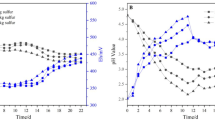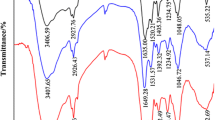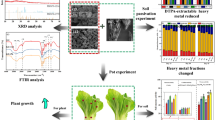Abstract
Purpose
Sulfate-reducing bacteria (SRB) is considered a promising bioremediation technology for stabilization of metals in soil. The study investigated the stabilization efficiencies of metal-chelant complexes by SRB in the chelator-washed soil and explored the relevant mechanisms.
Materials and methods
The two SRB strains (10%, OD600 = 1) and their mixture (v:v = 1:1) were inoculated into the mixed chelator (MC)–washed alkaline (AL) and acidic (AC) soils to treat the residual metal (Cd, Pb, Cu, and Zn)–chelant complexes. The treatment groups included CK-AL/AC (deionized water + soil), S-AL/AC (Shewanella JN01 + soil), C-AL/AC (Clostridium ZG01 + soil), and M-AL/AC (the mixed two strains + soil). Total and available heavy metals and soil physicochemical properties were measured. Bacterial community composition was analyzed by a high-throughput sequencing technique.
Results and discussion
The results showed that SRB treatment increased the reduction efficiencies of SO42- by 63.84–85.80% and 51.45–60.17% in the MC-washed alkaline and acidic soils, respectively. SRB had higher stabilization efficiencies of metal-chelant complexes in the MC-washed alkaline soil (13.07–64.95%) than those in the MC-washed acidic soil (< 13%), mainly because alkaline condition was more favorable for the dechelation of metal-chelant complexes by SRB to form metal sulfide precipitation. The inoculation of SRB into the MC-washed alkaline soil more successfully stimulated indigenous bacteria than the MC-washed acidic soil did, contributing to larger numbers of positive correlations between bacterial genera (dominantly from Firmicutes) and metal stabilization efficiencies in the MC-washed alkaline soil. Additionally, less elevation degree of MC-washed alkaline soil pH after SRB treatment (~ 0.1) than those in the MC-washed acidic soil (0.72–1.02) was more conducive to adsorption of negatively charged metal-chelant complexes on the MC-washed alkaline soil. The stabilization efficiencies of different metal-chelant complexes are not only related to their stability constant and availability but also associated with the solubility constants of metal sulfide.
Conclusions
The SRB treatment is a promising green technology for stabilizing metal-chelant complexes in chelator-washed soils, particularly effective in the MC-washed alkaline soil.
Graphical Abstract





Similar content being viewed by others
Data availability
Data will be made available on request.
Abbreviations
- AC:
-
The washed acidic soil
- AL:
-
The washed alkaline soil
- AN:
-
Available nitrogen
- AP:
-
Available phosphorus
- C:
-
Clostridium ZG01
- CA:
-
Citric acid
- CEC:
-
Cation exchange capacity
- EDDS:
-
S,S-ethylene-diamine-disuccinic acid
- EDTA:
-
Ethylenediaminetetraacetic acid
- GLDA:
-
N, N-bis(carboxymethyl) glutamic acid
- ICP-OES:
-
Inductively coupled plasma-optical emission spectrometry
- M:
-
The mixed two strains
- MC:
-
The mixed chelator
- OM:
-
Organic matter
- S:
-
Shewanella JN01
- SRB:
-
Sulfate-reducing bacteria
- TN:
-
Total nitrogen
- TP:
-
Total phosphorus
- XRD:
-
X-ray diffraction
References
Alexandrino M, Costa R, Canario AVM, Costa MC (2014) Clostridia initiate heavy metal bioremoval in mixed sulfidogenic cultures. Environ Sci Technol 48(6):3378–3385. https://doi.org/10.1021/es4052044
Antoniadis V, Koliniati R, Efstratiou E, Golia E, Petrophoulos S (2016) Effect of soils with varying degree of weathering and pH values on phosphorus sorption. CATENA 139:214–219. https://doi.org/10.1016/j.catena.2016.01.008
Beiyuan JZ, Lau AYT, Tsang DCW, Zhang WH, Kao CM, Baek K, Ok YS, Li XD (2018) Chelant-enhanced washing of CCA-contaminated soil: coupled with selective dissolution or soil stabilization. Sci Total Environ 612:1463–1472. https://doi.org/10.1016/j.scitotenv.2017.09.015
Castro L, Blazquez ML, Gonzalez F, Munoz JA, Ballester A (2016) Anaerobic bioleaching of jarosites by Shewanella putrefaciens, influence of chelator and bopfilm formation. Hydrometallurgy 168:56–63. https://doi.org/10.1016/j.hydromet.2016.08.002
Chen C, Li LY, Huang K, Zhang J, Xie WY, Lu YH, Dong XZ, Zhao FJ (2019) Sulfate-reducing bacteria and methanogens are involved in arsenic methylation and demethylation in paddy soils. ISME J 13(10):2523–2535. https://doi.org/10.1038/s41396-019-0451-7
Chen Y, Chen FF, Xie MD, Jiang QQ, Chen WQ, Ao TQ (2020) The impact of stabilizing amendments on the microbial community and metabolism in cadmium-contaminated paddy soils. Chem Eng J 395:125132. https://doi.org/10.1016/j.cej.2020.125132
Chen GZ, Lu QQ, Bai JH, Wen LX, Zhang GL, Wang W, Wang C, Liu Z (2022) Organic sulfur mineralization in surface soils from coastal wetlands with different flooding periods affected by the flow-sediment regulation in the Yellow River Delta, China. Catena 215:106343. https://doi.org/10.1016/j.catena.2022.106343
Cheng YQ, Pan S, Xu S, Su M, Liang QQ, Wang Y, Wang HH, Li Z, Yang ZM, Yang LZ (2023) The high accumulation of phosphorus in high-yield paddy soils: a new insight from cutans. Geoderma 429:116249. https://doi.org/10.1016/j.geoderma.2022.116249
Fleming M, Tai YP, Zhuang P, McBride MB (2013) Extractability and bioavailability of Pb and As in historically contaminated orchard soil: effects of compost amendments. Environ Pollut 177:90–97. https://doi.org/10.1016/j.envpol.2013.02.013
Gu WZ, Zheng DC, Li DP, Wei CC, Wang X, Yang QZM, Tian C, Cui MY (2021) Integrative effect of citrate on Cr(VI) and total Cr removal using a sulfate-reducing bacteria consortium. Chemosphere 279:130437. https://doi.org/10.1016/j.chemosphere.2021.130437
Guan W, Zhang BF, Tian SC, Zhao X (2018) The synergism between electro-Fenton and electrocoagulation process to remove Cu-EDTA. Appl Catal B: Environ 227:252–257. https://doi.org/10.1016/j.apcatb.2017.12.036
Guo XF, Wei ZB, Penn CJ, Xu TF, Wu QT (2013) Effect of soil washing and liming on bioavailability of heavy metals in acid contaminated soil. Soil Sci Soc Am J 77(2):432. https://doi.org/10.2136/sssaj2011.0371
Guo XF, Zhang GX, Wei ZB, Zhang LP, He QS, Wu QT, Qian TW (2018) Mixed chelators of EDTA, GLDA, and citric acid as washing agent effectively remove Cd, Zn, Pb, and Cu from soils. J Soils Sediments 18(3):835–844. https://doi.org/10.1007/s11368-017-1781-6
Hakansson T, Sjöberg S, Mattiasson B (2012) Treatment of metal ions and metal-chelate complexes in water with biologically produced H2S. Int J Environ Waste Manag 9(3–4):330–346. https://doi.org/10.1504/ijewm.2012.046396
Hazrati S, Farahbakhsh M, Heydarpoor G, Besalatpour AA (2020) Mitigation in availability and toxicity of multi-metal contaminated soil by combining soil washing and organic amendments stabilization. Ecotox Environ Safe 201:110807. https://doi.org/10.1016/j.ecoenv.2020.110807
Hu XS, Liu XX, Qiao LK, Zhang S, Su KW, Qiu ZL, Li XH, Zhao QC, Yu CH (2021a) Study on the spatial distribution of ureolytic microorganisms in farmland soil around tailings with different heavy metal pollution. Sci Total Environ 775:144946. https://doi.org/10.1016/j.scitotenv.2021.144946
Hu W, Niu YL, Zhu H, Dong K, Wang DQ, Liu F (2021b) Remediation of zinc-contaminated soils by using the two-step washing with citric acid and water-soluble chitosan. Chemosphere 282:131092. https://doi.org/10.1016/j.chemosphere.2021.131092
Huang R, Cui XY, Luo XZ, Mao P, Zhuang P, Li YX, Li YW, Li ZA (2021) Effects of plant growth regulator and chelating agent on the phytoextraction of heavy metals by Pfaffia glomerata and on the soil microbial community. Environ Pollut 283: 117159. https://doi.org/10.1016/j.envpol.2021.117159
Huttunen-Saarivirta E, Rajala P, Bomberg M, Carpén L (2017) Corrosion of copper in oxygen-deficient groundwater with and without deep bedrock micro-organisms: characterisation of microbial communities and surface processes. Appl Surf Sci 396:1044–1057. https://doi.org/10.1016/j.apsusc.2016.11.086
Jackson VA, Pulse AN, Odendaal JP, Khan S, Khan W (2012) Identification of metal-tolerant organisms isolated from the Plankenburg River, Western Cape. South Africa Water SA 38(1):29–38. https://doi.org/10.4314/wsa.v38i1.5
Kasemodel MC, Sakamoto IK, Varesche MBA, Rodrigues VGS (2019) Potentially toxic metal contamination and microbial community analysis in an abandoned Pb and Zn mining waste deposit. Sci Total Environ 675:367–379. https://doi.org/10.1016/j.scitotenv.2019.04.223
Kaurin A, Gluhar S, Tilikj N, Lestan D (2020) Soil washing with biodegradable chelating agents and EDTA: effect on soil properties and plant growth. Chemosphere 260:127673. https://doi.org/10.1016/j.chemosphere.2020.127673
Kiran MG, Pakshirajan K, Das G (2017) Heavy metal removal from multicomponent system by sulfate reducing bacteria: mechanism and cell surface characterization. J Hazard Mater 324:62–70. https://doi.org/10.1016/j.jhazmat.2015.12.042
Li Y, Kawashima N, Li J, Chandra AP, Gerson AR (2013) A review of the structure, and fundamental mechanisms and kinetics of the leaching of chalcopyrite. Adv Colloid Interface Sci 197:1–32. https://doi.org/10.1016/j.cis.2013.03.004
Li X, Wu YE, Zhang C, Liu YG, Zeng GM, Tang XQ, Dai LH, Lan SM (2016a) Immobilizing of heavy metals in sediments contaminated by nonferrous metals smelting plant sewage with sulfate reducing bacteria and micro zero valent iron. Chem Eng J 306:393–400. https://doi.org/10.1016/j.cej.2016.07.079
Li X, Dai LH, Zhang C, Zeng GM, Liu YG, Zhou C, Xu WH, Wu YE, Tang XQ, Liu W, Lan SM (2016b) Enhanced biological stabilization of heavy metals in sediment using immobilized sulfate reducing bacteria beads with inner cohesive nutrient. J Hazard Mater 324:340–347. https://doi.org/10.1016/j.jhazmat.2016.10.067
Li X, Lan SM, Zhu ZP, Zhang C, Zeng GM, Liu YG, Cao WC, Song B, Yang H, Wang SF, Wu SH (2018) The bioenergetics mechanisms and applications of sulfate-reducing bacteria in remediation of pollutants in drainage: a review. Ecotox Environ Safe 158:162–170. https://doi.org/10.1016/j.ecoenv.2018.04.025
Li YC, Ning JF, Li Q, Li LF, Bolan NS, Singh BP, Wang HL (2023) Effects of iron and nitrogen-coupled cycles on cadmium availability in acidic paddy soil from Southern China. J Soils Sediments 23:431–445. https://doi.org/10.1007/s11368-022-03328-3
Liu GN, Wang J, Liu X, Liu XH, Li XS, Ren YQ, Wang J, Dong LM (2018) Partitioning and geochemical fractions of heavy metals from geogenic and anthropogenic sources in various soil particle size fractions. Geoderma 312:104–113. https://doi.org/10.1016/j.geoderma.2017.10.013
Lu RK (2000) Analytical Methods of Soil Agro-chemistry. China Agriculture Science Technology Press, Beijing
Lützow MV, Kögel-Knabner I, Ekschmitt K, Matzner E, Guggenberger G, Marschner B, Flessa H (2006) Stabilization of organic matter in temperate soils: mechanisms and their relevance under different soil conditions-a review. Eur J Soil Sci 57:426–445. https://doi.org/10.1111/j.1365-2389.2006.00809.x
Ma WY, Sun T, Xu YM, Zheng SN, Sun YB (2022) In-situ immobilization remediation, soil aggregate distribution, and microbial community composition in weakly alkaline Cd-contaminated soils: a field study. Environ Pollut 292:118327. https://doi.org/10.1016/j.envpol.2021.118327
Matos LP, Costa PF, Moreira M, Gomes PCS, Silva SQ, Gurgel LVA, Teixeira MC (2018) Simultaneous removal of sulfate and arsenic using immobilized non-traditional SRB mixed culture and alternative low-cost carbon sources. Chem Eng J 334:1630–1641. https://doi.org/10.1016/j.cej.2017.11.035
Moghal AAB, Reddy KR, Mohammed SAS, Al-Shamrani MA, Zahid WM (2017) Sorptive response of chromium (Cr+6) and mercury (Hg+2) from aqueous solutions using chemically modified soils. J Test Eval 45:105–1019. https://doi.org/10.1520/JTE20160066
Moghal AAB, Mohammed SAS, Almajed A, Al-Shamrani MA (2020) Desorption of heavy metals from lime-stabilized arid-soils using different extractants. Int J Civ Eng 18(4):449–461. https://doi.org/10.1007/s40999-019-00453-y
Moghal AAB, Rasheed RM, Mohammed SAS (2022) Sorptive and desorptive response of divalent heavy metal ions from EICP-treated plastic fines. Indian Geotech J 1–19. https://doi.org/10.1007/s40098-022-00638-8
Muehe EM, Adaktylou IJ, Obst M, Zeitvogel F, Behrens S, Planer-Friedrich B, Kraemer U, Kappler A (2013) Organic carbon and reducing conditions lead to cadmium immobilization by secondary Fe mineral formation in a pH-neutral soil. Environ Sci Technol 47(23):13430–13439. https://doi.org/10.1021/es403438n
Niu ZS, Pan H, Guo XP, Lu DP, Feng JN, Chen YR, Tou FY, Liu M, Yang Y (2018) Sulphate-reducing bacteria (SRB) in the Yangtze Estuary sediments: abundance, distribution and implications for the bioavailibility of metals. Sci Total Environ 634:296–304. https://doi.org/10.1016/j.scitotenv.2018.03.345
Pan Y, Fu YQ, Liu SJ, Ma TF, Tao XQ, Ma Y, Fan S, Dang Z, Lu GN (2022) Spatial and temporal variations of metal fractions in paddy soil flooding with acid mine drainage. Environ Res 212:113241. https://doi.org/10.1016/j.envres.2022.113241
Pinto ISS, Neto IFF, Soares HMVW (2014) Biodegradable chelating agents for industrial, domestic, and agricultural applications-a review. Environ Sci Pollut Res 21(20):11893–11906. https://doi.org/10.1007/s11356-014-2592-6
Piri M, Sepehr E, Rengel Z (2019) Citric acid decreased and humic acid increased Zn sorption in soils. Geoderma 341:39–45. https://doi.org/10.1016/j.geoderma.2018.12.027
Shan SP, Guo ZH, Lei P, Wang YS, Li YL, Cheng W, Zhang M, Wu SD, Yi HW (2019) Simultaneous mitigation of tissue cadmium and lead accumulation in rice via sulfate-reducing bacterium. Ecotox Environ Safe 169:292–300. https://doi.org/10.1016/j.ecoenv.2018.11.030
Stevens RJ, Laughlin RJ, Malone JP (1998) Soil pH affects the processes reducing nitrate to nitrous oxide and di-nitrogen. Soil Biol Biochem 30(8–9):1119–1126. https://doi.org/10.1016/S0038-0717(97)00227-7
Su Z, Li X, Xi YN, Xie TH, Liu YF, Liu B, Liu HN, Xu WH, Zhang C (2022) Microbe-mediated transformation of metal sulfides: mechanisms and environmental significance. Sci Total Environ 825:153767. https://doi.org/10.1016/j.scitotenv.2022.153767
Wang GY, Zhang SR, Zhong QM, Xu XX, Li T, Jia YX, Zhang YZ, Peijnenburg WJGM, Vijver MG (2018a) Effect of soil washing with biodegradable chelators on the toxicity of residual metals and soil biological properties. Sci Total Environ 625:1021–1029. https://doi.org/10.1016/j.scitotenv.2018.01.019
Wang GY, Zhang SR, Zhong QM, Peijnenburg WJGM, Vijver MG (2018b) Feasibility of Chinese cabbage (Brassica bara) and lettuce (Lactuca sativa) cultivation in heavily metals-contaminated soil after washing with biodegradable chelators. J Clean Prod 197:479–490. https://doi.org/10.1016/j.jclepro.2018.06.225
Wang QW, Chen JJ, Zheng AH, Shi LX (2019) Dechelation of Cd-EDTA complex and recovery of EDTA from simulated soil-washing solution with sodium sulfide. Chemosphere 220:1200–1207. https://doi.org/10.1016/j.chemosphere.2018.12.212
Wang GY, Pan XM, Zhang SR, Zhong QM, Zhou W, Zhang XH, Wu J, Vijver MG, Peijnenburg WJGM (2020a) Remediation of heavy metal contaminated soil by biodegradable chelator–induced washing: efficiencies and mechanisms. Environ Res 186:109554. https://doi.org/10.1016/j.envres.2020.109554
Wang GZ, Wang DD, Song YM, Chen R, Chen ZQ, Du MA (2020b) Enhanced production of volatile fatty acids by adding a kind of sulfate reducing bacteria under alkaline pH. Colloids Surf B 195:111249. https://doi.org/10.1016/j.colsurfb.2020.111249
Wang Y, Luo Y, Zeng GQ, Wu XD, Wu B, Li X, Xu H (2020c) Characteristics and in situ remediation effects of heavy metal immobilizing bacteria on cadmium and nickel co-contaminated soil. Ecotox Environ Safe 192:110294. https://doi.org/10.1016/j.ecoenv.2020.110294
Wang F, Peng SQ, Fan L, Li Y (2022) Improved sulfate reduction efficiency of sulfate-reducing bacteria in sulfate-rich systems by acclimatization and multiple-grouting. Alex Eng J 61(12):9993–10005. https://doi.org/10.1016/j.aej.2022.03.046
Wu B, Wang ZR, Zhao YX, Gu YM, Wang Y, Yu J, Xu H (2019) The performance of biochar-microbe multiple biochemical material on bioremediation and soil micro-ecology in the cadmium aged soil. Sci Total Environ 686:719–728. https://doi.org/10.1016/j.scitotenv.2019.06.041
Wu B, Liu FF, Fang WW, Yang T, Chen GH, He ZL, Wang SQ (2021) Microbial sulfur metabolism and environmental implications. Sci Total Environ 778:146085. https://doi.org/10.1016/j.scitotenv.2021.146085
Xu JY, Wang XL, Wang JB, Xu LG, Zheng XW, Zhang YP, Hu CH (2021) Dominant environmental factors influencing soil metal concentrations of Poyang Lake wetland, China: Soil property, topography, plant species and wetland type. Catena 207:105601. https://doi.org/10.1016/j.catena.2021.105601
Yang F, Zhai WW, Li ZJ, Huang Y, Manzoor M, Yang B, Hou Y, Lei LC, Tang XJ (2021) Immobilization of lead and cadmium in agricultural soil by bioelectrochemical reduction of sulfate in underground water. Chem Eng J 422:130010. https://doi.org/10.1016/j.cej.2021.130010
Yoo JC, Beiyuan JZ, Wang L, Tsang DCW, Baek K, Bolan NS, Ok YS, Li XD (2018) A combination of ferric nitrate/EDDS-enhanced washing and sludge-derived biochar stabilization of metal-contaminated soils. Sci Total Environ 616:572–582. https://doi.org/10.1016/j.scitotenv.2017.10.310
Yuan CL, Li FB, Cao WH, Yang Z, Hu M, Sun WM (2019) Cadmium solubility in paddy soil amended with organic matter, sulfate, and iron oxide in alternative watering conditions. J Hazard Mater 378:120672. https://doi.org/10.1016/j.jhazmat.2019.05.065
Yuan CL, Na S, Li FB, Hu HW (2021) Impact of sulfate and iron oxide on bacterial community dynamics in paddy soil under alternate watering conditions. J Hazard Mater 408:124417. https://doi.org/10.1016/j.jhazmat.2020.124417
Zhai XQ, Li ZW, Huang B, Luo NL, Huang M, Zhang Q, Zeng GM (2018) Remediation of multiple heavy metal-contaminated soil through the combination of soil washing and in situ immobilization. Sci Total Environ 635:92–99. https://doi.org/10.1016/j.scitotenv.2018.04.119
Zhang WH, Tong LZ, Yuan Y, Liu ZY, Huang H, Tan FF, Qiu RL (2010) Influence of soil washing with a chelator on subsequent chemical immobilization of heavy metals in a contaminated soil. J Hazard Mater 178(1–3):578–587. https://doi.org/10.1016/j.jhazmat.2010.01.124
Zhang GX, Guo XF, Zhao ZH, He QS, Wang SF, Zhu YE, Yan YL, Liu XT, Sun K, Zhao Y, Qian TW (2016) Effects of biochars on the availability of heavy metals to ryegrass in an alkaline contaminated soil. Environ Pollut 218:513–522. https://doi.org/10.1016/j.envpol.2016.07.031
Zhang FS, Zhang GX, Liao XY (2021a) Negative role of biochars in the dissipation and vegetable uptake of polycyclic aromatic hydrocarbons (PAHs) in an agricultural soil: cautions for application of biochars to remediate PAHs-contaminated soil. Ecotox Environ Safe 213:112075. https://doi.org/10.1016/j.ecoenv.2021.112075
Zhang GX, Zhao ZH, Yin XA, Zhu YE (2021b) Impacts of biochars on bacterial community shifts and biodegradation of antibiotics in an agricultural soil during short-term incubation. Sci Total Environ 771:144751. https://doi.org/10.1016/j.scitotenv.2020.144751
Funding
This study was funded by the Natural Science Foundation of Shanxi Province (No. 20210302123204).
Author information
Authors and Affiliations
Contributions
Guixiang Zhang: methodology, data analysis, original draft, validation, and funding; Yu Gao: experiment, writing original draft, data analysis, and diagramming; Rui Ren: experiment, characterization, and data analysis; Xiaofang Guo: investigation, project administration, funding, resources, supervision; Baoshan Xing: validation, reviewing, and editing; Yang Li: data analysis and editing; Zheyun Zhang: determination and diagramming; Hao Wu: validation and editing.
Corresponding author
Ethics declarations
Conflict of interest
The authors declare no competing interests.
Additional information
Responsible editor: Dan Tsang
Publisher's Note
Springer Nature remains neutral with regard to jurisdictional claims in published maps and institutional affiliations.
Supplementary Information
Below is the link to the electronic supplementary material.
Rights and permissions
Springer Nature or its licensor (e.g. a society or other partner) holds exclusive rights to this article under a publishing agreement with the author(s) or other rightsholder(s); author self-archiving of the accepted manuscript version of this article is solely governed by the terms of such publishing agreement and applicable law.
About this article
Cite this article
Zhang, G., Gao, Y., Ren, R. et al. Enhanced biological stabilization of metal-chelant complexes in the chelator-washed soils by sulfate-reducing bacteria. J Soils Sediments 23, 2457–2472 (2023). https://doi.org/10.1007/s11368-023-03487-x
Received:
Accepted:
Published:
Issue Date:
DOI: https://doi.org/10.1007/s11368-023-03487-x




